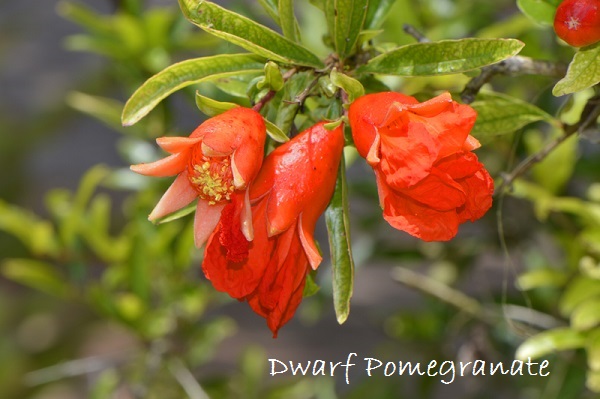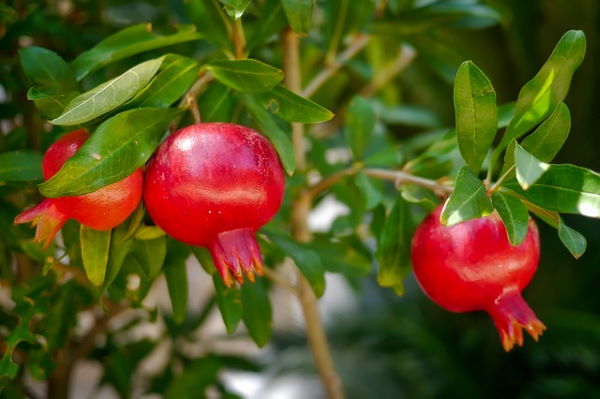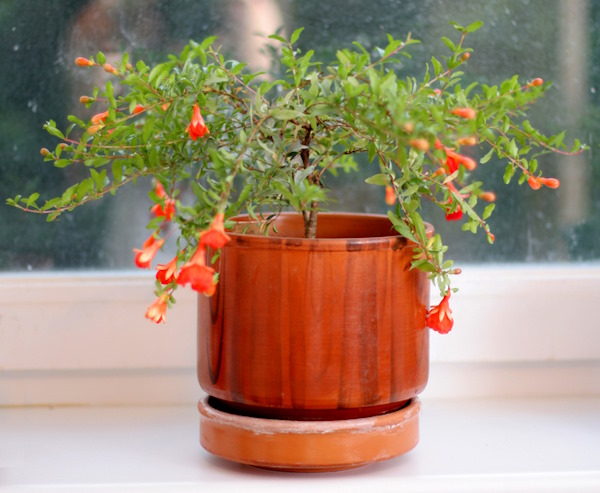Dwarf Pomegranate
Botanical Name: Punica granatum 'Nana'
Give dwarf pomegranate tree a sunny window -- and you'll enjoy this petite charmer year-round. This is a compact cultivar that is easy to grow as a house plant.
Here, you'll get houseplant tips for growing pomegranate, including how to prune your houseplant, when to water and fertilize, plus how much sunlight it wants year-round.
 Red tubular flowers cover this small plant in early summer. Photo © Peter Etchells
Red tubular flowers cover this small plant in early summer. Photo © Peter EtchellsYou can expect pomegranates' woody branches to be covered with 1-inch (2.5 cm) leaves most of the year. Don't be surprised when this pint-sized tree drops most of its leaves in winter -- it's normal.
And in summer, you'll enjoy the orange-red, tubular flowers followed by 2-inch (5 cm) fruits. Pomegranates may take several months to ripen, so don't give up on it. Yes, they're edible -- but small. They're also less sweet than those from the full-size pomegranate tree. Consider your dwarf pomegranate purely decorative.
Buying Tips
You can buy dwarf pomegranate plants at some garden centers and online in spring and summer. Look for the Punica granatum 'Nana' name to be sure you're getting this dwarf cultivar.
Dwarf Pomegranate Tree Care
No blooms? Give your dwarf pomegranate tree some sun year-round. It won't bloom without sunlight. And don't be in a hurry to pot up -- it blooms best when slightly pot-bound.
Don't pick faded flowers -- leave them on the plant because those flowers will produce pomegranates.
Got blooms, but no fruit? Some types of pomegranate trees are self-pollinating, but not all. Fruit trees grown outdoors are pollinated from the wind or insects that carry the pollen from flower to flower. If you've kept your plant indoors, it needs some help from you. Don't worry -- it's easy to do. How to pollinate your pomegranate: Use a small, clean paintbrush to dab the stamens in the center of the flowers, moving from flower to flower to spread the pollen around.
 Given plenty of warm sunshine, fruits will decorate this ornamental tree. Photo: Albrecht Fietz
Given plenty of warm sunshine, fruits will decorate this ornamental tree. Photo: Albrecht FietzPrune your plant. Pruning pomegranate trees will keep them shapely -- and compact. You'll also encourage more flower buds to form. Prune in spring, removing old wood and long side branches. Once you get in the habit of yearly pruning, it's hardly any work at all.
Repot in spring. Repot only when the roots have filled the pot. Move to a pot only 1-2 inches (2.5-5 cm) larger. This small tree blooms best when pot-bound. Use a pot with a drainage hole to prevent overwatering, which can cause root rot.
Something bugging your plants? Check your house plants regularly for aphids. They're attracted to soft, new growth and tend to hang out on flower buds and young stems. If you find an infestation, treat your plant right away because these little pests multiply quickly and can harm your plants.
Overwintering your dwarf pomegranate: In winter, you can expect most, if not all, the leaves to fall off your tree. Give it a winter rest by reducing water, but don't allow the potting medium to dry out completely. Stop fertilizing till spring. Keep your plant in a bright, slightly cooler location.
 Photo © elquest
Photo © elquestDwarf Pomegranate Care Tips
Origin: Southeastern Mediterranean to the Himalayas
Height: Up to 3 ft (90 cm). Pomegranate bonsai trees are kept shorter.
Light: Bright light to full sun. Plants that don't bloom aren't getting enough light. Put your tree where it will get bright light with some direct sunlight every day. Moving it outdoors for the summer is ideal. Just be sure to bring it back before the temperature drops to 50° at night.
Water: Keep potting medium evenly moist, but not soggy which can lead to root rot. Fruit trees are thirsty during the growing season and need ample water, so check it often. Water sparingly in the winter when growth is extremely slow.
Humidity: Moderate room (around 40-50% relative humidity). Indoor humidity levels can drop drastically in a heated home in winter. If indoor air is dry, you can increase humidity for your houseplants.
Temperature: Normal room temperatures 65-75°F/18-24°C. Dwarf pomegranate will tolerate a minimum of 50°F/10°C in the winter.
Soil: Good-quality, all-purpose potting mix. Do not use garden soil because it will become too compact in a container.
Fertilizer: Feed every 2 weeks spring through fall with a water-soluble fertilizer specially made for fruit trees.
Propagation: Take 3-4 in (7.5-10 cm) stem tip cuttings in spring. Sow seeds in spring. Soak seeds overnight in warm water before sowing in seed starting mix. Keep seeds warm and barely moist. Seeds will germinate in about 3-4 weeks.


